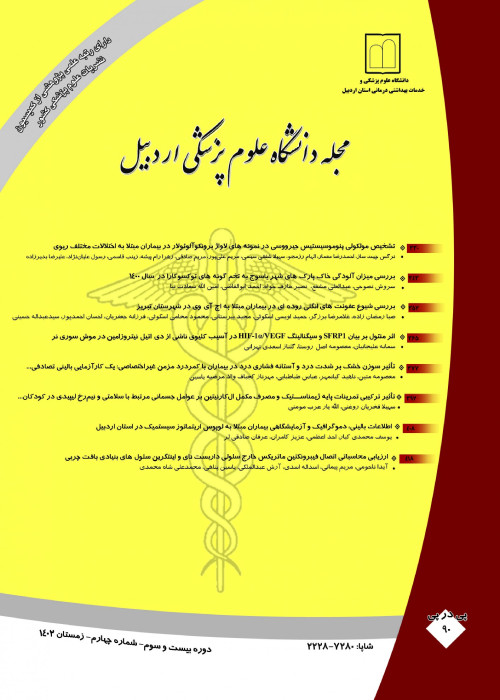Skin Lesions in Diabetic Patients Refering to Dermatology and Diabetes Clinic of Sina Hospital, Tabriz
Author(s):
Abstract:
Background and Objectives
Diabetes mellitus (DM) is a clinically and genitically heterogeneous group of disorders characterized by abnormally high levels of glucose in blood. The skin is involved both in the effects of acute metabolic changes and in the chronic degenerative compilications of diabetes. Skin lesions are frequently observed in diabetic patients and it is generally stated that about 30% of these patients have cutaneous disorders. The aim of this study was to assess the prevalence of skin lesion in patients with diabetes mellitus referring to dermatology and diabetes clinic of Sina hospital in Tabriz. Methods
This descriptive-analytical study was conducted on diabetic patients with skin lesion who referr e d to diabetic and dermatology clinic of Sina hospital of Tabriz during 2003. Data collecting instrument was a questionnaire which included some variables such as age, sex, job, type of diabetes, its duration, control of blood glucose, receiving regular treatment, type of lesion. The questionnaire was filled out for each patient with skin lesion individally. Skin lesions due to burn were excluded from our study. The data were analyzed by SPSS using Chi-aquare and Fisher test. Results
From a total of 500 patients, 80 patients (16%) had skin lesions. 57.5% of these patients was male and 91.2% had type II DM. Mean age of the patients with skin lesion was 56.86±1.54 years and mean diabetes duration was 10.87±0.82 years. Patients over 50 years had the most skin lesion. The most common type of skin lesion in the diabetic patients were 30 cases of necrotic ulcer (6%) and 22 cases of diabetic dermopathy (4.4%) respectively. Other skin lesions such as infection, sclerodermoid, punched out lesions, neuropathic ulcer, diabetic bulla, dermatitis and lichen planus were not common. 97.5% of diabetic patients with skin lesion had poor control of blood glucose. Twelve percent of the patients had some kind of diabetic foot ulcer (Neuropathic Necrotic, punched out and cellulitis ulcer altogether) of which 21.6% underwent amputation. Conclusion
The results showed that rate of skin lesions in diabetic patients is decreased. compared to the past. This may be due to increase of knowledge and attitude of patients regarding diabetes and its complications.Keywords:
Language:
Persian
Published:
Journal of Ardabil University of Medical Sciences, Volume:6 Issue: 20, 2006
Page:
170
magiran.com/p493495
دانلود و مطالعه متن این مقاله با یکی از روشهای زیر امکان پذیر است:
اشتراک شخصی
با عضویت و پرداخت آنلاین حق اشتراک یکساله به مبلغ 1,390,000ريال میتوانید 70 عنوان مطلب دانلود کنید!
اشتراک سازمانی
به کتابخانه دانشگاه یا محل کار خود پیشنهاد کنید تا اشتراک سازمانی این پایگاه را برای دسترسی نامحدود همه کاربران به متن مطالب تهیه نمایند!
توجه!
- حق عضویت دریافتی صرف حمایت از نشریات عضو و نگهداری، تکمیل و توسعه مگیران میشود.
- پرداخت حق اشتراک و دانلود مقالات اجازه بازنشر آن در سایر رسانههای چاپی و دیجیتال را به کاربر نمیدهد.
In order to view content subscription is required
Personal subscription
Subscribe magiran.com for 70 € euros via PayPal and download 70 articles during a year.
Organization subscription
Please contact us to subscribe your university or library for unlimited access!


